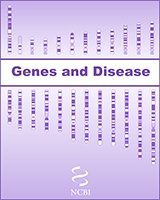NCBI Bookshelf. A service of the National Library of Medicine, National Institutes of Health.
National Center for Biotechnology Information (US). Genes and Disease [Internet]. Bethesda (MD): National Center for Biotechnology Information (US); 1998-.

Fibrodysplasia Ossificans Progressiva (FOP) is an extremely rare genetic disease that causes muscle to be turned into bone. The condition was first reported in the 17th century by Patin, a French physician, who described a woman who "turned into wood". The wood he described was actually the formation of new bone.
FOP is an autosomal dominant condition, but most cases are sporadic. FOP patients have a genetic fault, which means that their bodies cannot switch off the mechanism that grows the skeleton in the womb. Any small injury to connective tissue (muscles, ligaments, and tendons) can result in the formation of hard bone around the damaged site. Children are born with a characteristic malformation of the great toes and begin to develop heterotopic (extra) bone formation during early childhood. Eventually, a second skeleton begins to form that severely restricts mobility.
FOP affects 1 of 2 million people. Because of the very small numbers of patients, identifying the mutation(s) causing FOP is difficult. There are several genes that have been implicated in the disease process. For example, when the Noggin gene (NOG) is deleted in mice, the mice are unable to stop the deposition of bone, causing an FOP-like disease. Another gene of interest is the Bone Morphogenic Protein gene (BMP), which Noggin regulates. Proteins encoded by BMP induce bone formation, and one of their roles is to stimulate the formation of the fetal skeleton. In FOP, lymphocytes deliver BMP4 to areas of damaged muscle, and so initiate bone growth rather than aid tissue repair.
It is hoped that future studies will pinpoint the mutation(s) occurring in FOP and lead to a better understanding of the disease’s mechanism.
Related diseases
- Genome view see gene locations
- Entrez Gene collection of gene-related information
- BLink related sequences in different organisms
- Research articles online full text
- Books online books section
- OMIM catalog of human genes and disorders
- International Fibrodysplasia Ossificans Progressiva Association further information and patient support
- Fibrodysplasia ossificans progressiva - Genes and DiseaseFibrodysplasia ossificans progressiva - Genes and Disease
Your browsing activity is empty.
Activity recording is turned off.
See more...
